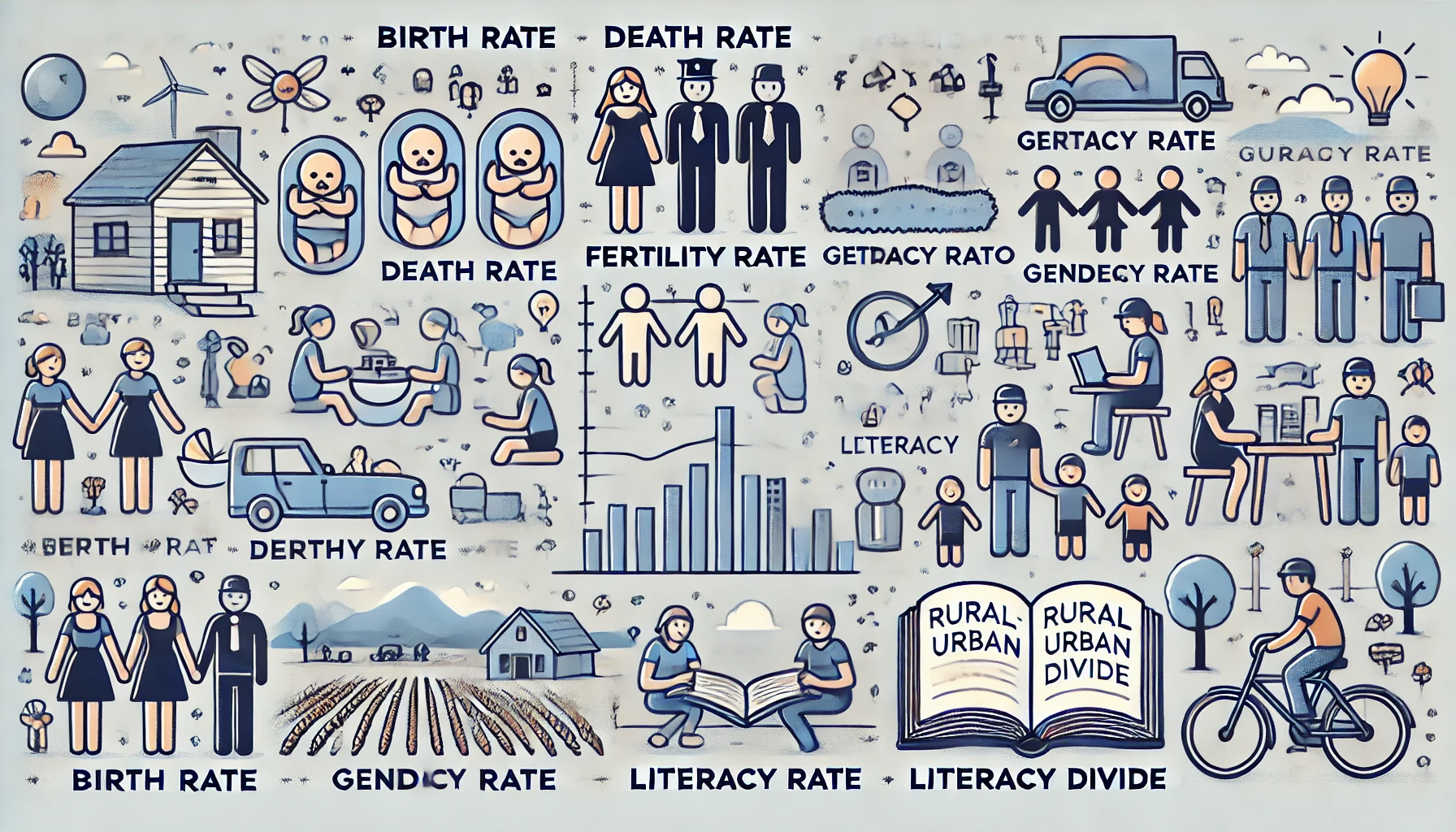1. Birth Rate:
- Definition: The birth rate is the number of live births per 1,000 people in a population per year.
- $$ Birth Rate = (Number of Live Births in a year) / (Total Population) *1000 $$
- Significance:
- Population Growth: A high birth rate indicates rapid population growth, which can lead to increased demand for resources, healthcare, education, and jobs. It is a key indicator of demographic changes and helps predict future population trends.
- Economic Planning: Countries with high birth rates need to invest in maternal health, childcare, and education to support growing populations, while low birth rates can signal the need for immigration policies to sustain economic growth.
- Dependency Ratios: A high birth rate usually results in a larger young population, which can increase the dependency ratio, meaning more people are reliant on a smaller working-age population to support them.
2. Death Rate:
- Definition: The death rate, or mortality rate, is the number of deaths per 1,000 people in a population per year.
- $$ Death Rate = (Number of Deaths in a year) / (Total Population) *1000 $$
- Significance:
- Healthcare and Life Expectancy: The death rate is a reflection of the healthcare system’s effectiveness and the overall health of a population. Lower death rates often correlate with better healthcare, nutrition, and living conditions.
- Aging Population: A declining death rate can lead to an aging population if birth rates are also low, which can increase pressure on pensions and healthcare systems as a larger proportion of the population is elderly.
- Public Health and Policy: High death rates may indicate public health crises, poor living conditions, or conflict, prompting governments to invest in healthcare, sanitation, and social services.
3. Fertility Rate:
- Definition: The fertility rate is the average number of children a woman is expected to have during her reproductive years (usually ages 15-49).
- $$ Fertility Rate = (Number of Births to Women in Specific Age group ) / (Total Number of Women in Specific Age Group ) *Age group weight$$
- Significance:
- Population Growth and Decline: Fertility rate is the primary driver of population growth or decline. High fertility rates typically lead to rapid population growth, while low fertility rates can lead to a shrinking population, which can strain economies.
- Economic Development: In countries with high fertility rates, governments need to invest more in education, healthcare, and job creation for a growing youth population. In countries with low fertility rates, aging populations may require higher spending on pensions and healthcare.
- Gender Equity and Family Planning: Fertility rates can also reflect social norms around family size, women’s participation in the workforce, and access to family planning services. A lower fertility rate is often associated with greater gender equity and access to reproductive healthcare.
4. Gender Ratio (Sex Ratio):
- Definition: The gender ratio, or sex ratio, is the number of males per 1,000 females in a population.
- $$ Gender Ratio = (Number of Males) / (Number of Females) *1000 $$
- Significance:
- Social Stability: A highly skewed gender ratio can create social challenges, such as gender-based violence, trafficking, and imbalances in marriage markets. This is often seen in societies that favor one gender, typically males.
- Economic Implications: An imbalance in gender ratios, especially in a male-dominated society, can affect labor market dynamics, family structures, and social stability, particularly in countries with cultural preferences for sons.
- Policy and Equality: A balanced gender ratio is important for promoting gender equality and ensuring that both males and females have equal opportunities in education, healthcare, and employment.
5. Literacy Rate:
- Definition: The literacy rate is the percentage of people aged 15 and above who can read and write with understanding in a specific population.
- $$ Literacy Rate = (Number Literate People Aged 15 and Above) / (Total Population Aged 15 and Above) *100 $$
- Significance:
- Human Capital Development: Literacy is a key indicator of a population’s educational attainment and human capital development. Higher literacy rates correlate with better economic opportunities, higher incomes, and improved social mobility.
- Economic Growth: Countries with high literacy rates are better positioned to grow economically, as a literate workforce is more productive, adaptable, and capable of contributing to innovation and technological advancement.
- Social Development: Literacy is essential for participation in civic life and access to information. It reduces poverty, improves health outcomes, and empowers individuals, particularly women, leading to more equitable societies.
6. Rural-Urban Divide:
- Definition: The rural-urban divide refers to the disparities in living standards, economic opportunities, and access to services between rural and urban areas.
- For Urban Population – $$ Rural-Urban Divide = (Urban Population) / (Total Population) *100 $$
- For Rural Population – $$ Rural-Urban Divide = (Rural Population) / (Total Population) *100 $$
- Significance:
- Economic Inequality: The rural-urban divide often reflects economic disparities, with urban areas typically having better access to healthcare, education, employment opportunities, and infrastructure compared to rural areas. Closing this divide is crucial for reducing poverty and promoting inclusive growth.
- Migration and Urbanization: A widening rural-urban divide often leads to rural-to-urban migration, which can strain urban infrastructure and lead to overcrowded cities, while rural areas suffer from a lack of investment and depopulation.
- Policy Focus: Governments use demographic data on the rural-urban divide to develop policies that balance regional development, improve rural infrastructure, and provide equal access to public services across geographic areas.
Conclusion:
These demographic indicators—birth rate, death rate, fertility rate, gender ratio, literacy rate, and the rural-urban divide—are critical for understanding the dynamics of a population and its future trends. They provide essential insights for policymakers, businesses, and international organizations to plan effectively for economic growth, resource allocation, social development, and sustainable urbanization

